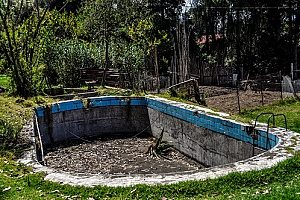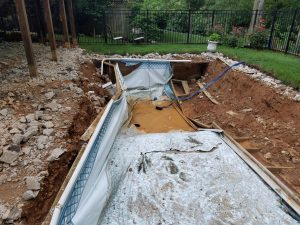 Inground swimming pool removal is important with pools in disrepair and of older construction. The inground pool removal is a simple process for the experienced and well equipment contractor. The initial site inspection looks for certain site conditions. The current inground pool area access, existing grade, size and depth of the pool are important site conditions, to consider. Site condition complexities can add to your pool removal costs. We will discuss the types of pool removal, the pool removal process and the importance of a licensed contractor for a successful swimming pool removal project.
Inground swimming pool removal is important with pools in disrepair and of older construction. The inground pool removal is a simple process for the experienced and well equipment contractor. The initial site inspection looks for certain site conditions. The current inground pool area access, existing grade, size and depth of the pool are important site conditions, to consider. Site condition complexities can add to your pool removal costs. We will discuss the types of pool removal, the pool removal process and the importance of a licensed contractor for a successful swimming pool removal project.
2 Types of Inground Pool Removal
The two types of inground pool removal options are total pool removal and partial pool removal. We will speak on both of these options.
1. Total/Full Pool Removal
 Check out a pool removal done by Dirt Connections!
Check out a pool removal done by Dirt Connections!
Total inground pool removal, requires heavy equipment. Heavy equipment will be used to demolish the existing pool concrete. The pool steel reinforcement can be 3/8″ to 1″ thick. Thick steel and concrete demands the use of heavy equipment. Heavy equipment will use hydraulic hammers to breakdown the concrete. Broken concrete allows for the removal of the concrete material from the ground. Concrete can now be loaded into dump trucks.
Concrete with rebar is expensive to haul off and dispose of. You can understand broken concrete with steel can be of little use to others. To reclaim this material into something into a useful sellable material requires expensive equipment and time. This adds to the expense of a total pool removal. This is complete removal of all inground pool items.
2. Partial Pool Removal
Partial pool removal involves heavy equipment, lighter in nature. This process includes the installation of holes at the bottom of the existing pool. The breakdown of the pool edge will ensure a successful project. Dirt Connections breaks down the swimming pool edge 36 inches below the existing grade or pool coping. The depth of 36 inches allows for plenty of safe ground cover grading over the partial pool removal.
Important Things To Consider About Pool Removal
 There are several considerations that must be taken into account when it comes to pool removal. Here are some things to look out for and pay close attention to while your pool removal is being completed.
There are several considerations that must be taken into account when it comes to pool removal. Here are some things to look out for and pay close attention to while your pool removal is being completed.
Holes At The Bottom Of The Pool
These holes allow for the transfer of water through the remaining concrete with a partial pool removal.
Pool Area Grading
With completion of the inground pool removal, the importation of fill dirt is necessary. The fill dirt will fill the void created by the total or partial pool removal. Fill dirt will be placed with a machine. As the machine places the fill dirt, compaction does occur. With continued fill dirt placement and compaction, the void will be filled.
Ground Cover
Grade work complete, you are now able to install your ground cover. This can be sod, grass seed or a combination of the two. Sod is grass with soil beneath it held together by its roots. Sod is grown and harvested from specialty farms. Grass seeds are produced in a variety of types. Some grass types are Fine Fescue, Kentucky Blue Grass, Rye Grass and St. Augustine Grass. Check with your local contractor for the proper grass type for your area.
Contractor License
You want to hire a licensed general contractor. Ask for a copy of the license. General contractor’s know-how to secure building permits and how to comply with all local ordinances. Knowing a licensed professional is going to complete your pool removal gives you peace of mind.
Contractors Insurance
 Contractors insurance is coverage that can protect the general contractor and the customer from devastating financial debts that can result from work-related accidents. It’s important to protect your livelihood. Customers need to be contractors have insurance. The three types of insurance for general contractors are, General Liability, Automobile Liability and Workers Compensation. You can request a copy of the certificate of insurance. This is a common practice.
Contractors insurance is coverage that can protect the general contractor and the customer from devastating financial debts that can result from work-related accidents. It’s important to protect your livelihood. Customers need to be contractors have insurance. The three types of insurance for general contractors are, General Liability, Automobile Liability and Workers Compensation. You can request a copy of the certificate of insurance. This is a common practice.
Project Inspection & Building Permit Closeout
Any time you are providing building, remodeling and or demolishing work to a property, you likely need a building permit. This provides for the legal permission from you city/county to begin work on your project. With legal permission, you can start work on your project. The start of your project, will lead to an end. At the end of your project, you must close out your permits. This usually includes a final inspection from an official with the building permit office. Don’t forget this step. Permits that remain open can cause serious issues. These issues can potentially act as a lien on the site and are a liability to the property seller. Permits left open for months or years after project completion can cause a major headache for people. Always seek an immediate final inspection and close out your permit.
Qualified Pool Removal Contractors & Dirt Suppliers
 Oftentimes general contractors need to order fill dirt and or topsoil for your pool removal project. Be sure the backfill deposited at your pool removal project is not contaminated. You do not want to install material that can be detrimental to the health of your property.
Oftentimes general contractors need to order fill dirt and or topsoil for your pool removal project. Be sure the backfill deposited at your pool removal project is not contaminated. You do not want to install material that can be detrimental to the health of your property.
5 Benefits of Pool Removal
1. Improved Safety
Swimming pool safety is important for your family. The fun a swimming pool provides can, unfortunately, be dangerous if not used conventionally.
2. Saves You Money
After the initial building cost, you will have the yearly maintenance fees and labor. Maintenance fees include the opening and closing of the pool. Who is going to do this work? You? Remember, proper pool maintenance needs to be done daily.
3. Can Increase Your Home’s Value
Removing your in ground swimming pool, in some cases increase the value of your home. Remember, all home buyers are not looking for a swimming pool.
4. Frees Up More Yard Space
 The removal of the swimming pool, can open up a huge amount of space in your yard. This allows for a variety of additional outdoor activities. As a reminder, a home without a swimming pool in disrepair can enhance property value.
The removal of the swimming pool, can open up a huge amount of space in your yard. This allows for a variety of additional outdoor activities. As a reminder, a home without a swimming pool in disrepair can enhance property value.
5. Reduced Insurance Fees
Without a swimming pool, you can remove swimming pool insurance from your homeowners’ insurance policy. This can lead to additional and significant annual insurance savings.
Preparing for a Smooth Pool Removal
When planning your inground swimming pool removal, consider the type of removal that fits your needs. Total pool removal involves demolishing the entire pool with heavy equipment, while partial removal is a less invasive option. Ensure proper site inspection and grading to accommodate fill dirt and ground cover. Verify that the contractor is licensed and insured to protect your investment. Don’t forget to close out building permits to avoid future issues. Proper planning and professional help are key to a successful pool removal project.
Dirt Connections can provide pool removal services and the necessary fill dirt material for your pool removal project.

Dirt Connections,
Right Here,
Right Now.








































